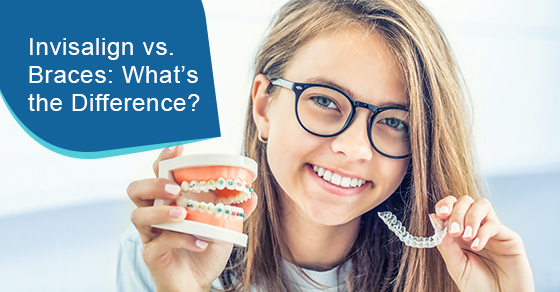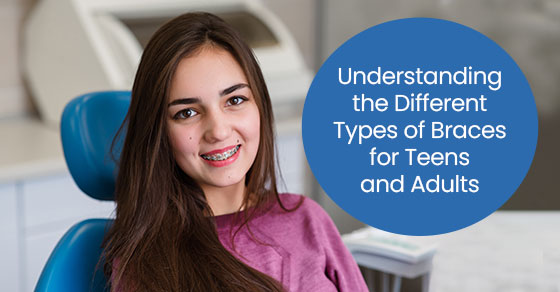Do you dream of a straight, perfect set of gleaming pearly whites? Do strangers who display a beautiful, enchanting smile mesmerize you? If so, you are certainly not alone in your admiration of a great smile. Many people throughout their lifetimes choose to undergo dental surgeries, braces or treatments to achieve or sustain a healthy smile. If you have been considering fixing your smile or your child’s teeth, you may be wondering what options you have when it comes to braces.
Traditionally, braces are attached to the teeth for the entire duration of treatment and are visible to others whenever you open your mouth, talk, eat or smile. Traditional braces can sometimes be a source of insecurity for self-conscious people about having noticeable fixtures on their teeth. This is one reason why invisible braces have become so popular nowadays. Invisible braces offer patients the ability to discreet their treatment while still reaping the benefits of a great smile. If you are looking to choose between traditional braces and Invisalign (invisible braces), read below for more information on both of these popular options.
What is Invisalign?
Most people are familiar with traditional metal braces and may know of someone who has had this type of treatment. Many young children have metal braces applied and kept on for many months. Metal braces are fixed onto the teeth and are non-removable.
On the other hand, Invisalign braces are made from clear plastic. Removable tray aligners made for your teeth. They are meant to be left on for most of the day and only removed for eating and drinking. These aligners must be changed every 4-6 weeks to accommodate the changes to your smile as the treatment progresses. Invisalign is known for being discreet, removable and most importantly- invisible. As opposed to metal braces, Invisalign is not easily noticeable. Continue reading as we compare some of the main attributes of both Invisalign and traditional braces.
Aesthetics
When considering the overall look of your mouth and smile, traditional metal braces are the more noticeable option. People will notice that you have braces, and it will be very difficult to hide this. If you don’t mind this, then traditional braces can be a good option for you. However, if you don’t like the look of conventional braces and prefer for your treatment to be less obvious, Invisalign will work wonders for you. Invisalign is often the preferred choice for older people or work in jobs that require them to maintain a certain look. These factors may also contribute to your choice as well.
Comparing Price
Normally, traditional braces are less expensive than Invisalign. Since Invisalign has the added benefit of being less noticeable, it can come with a heftier price tag. At Bristol Dental Clinic, we do not charge a premium for invisalign. Both the invisalign and braces are offered at the same price. However, your insurance may cover either dental treatment, and you can always discuss and compare pricing with your dentist. Both braces and Invisalign prices are based on the severity of the dental issues and can range in price depending on how long you need them.
Which is More Comfortable?
Of course, comfort should be a priority when it comes to any extended treatment option. Thankfully, regardless of if you choose braces or Invisalign, you will most likely get used to the new sensation and pressure over time. However, since Invisalign applies less pressure to the teeth than traditional braces, they are seen as the more comfortable option. They also pose less of a risk for cutting and bruising to the inside of the mouth and lips.
Results from Treatment
Both Invisalign and traditional braces are highly effective methods of correcting teeth that can provide excellent results. Depending on the severity of your dental issues, your dentist will discuss and explain which treatment option can yield the best results. If your dental issues are complex, they may be beyond the scope of what Invisalign can fix. In these cases, your dentist will recommend traditional braces without a doubt. Traditional braces are more effective at treating severe dental problems as they can not be removed by the patient and can apply more pressure to the teeth than invisible braces. Please discuss your options with your dentist so that you can make an informed decision.
Patient Responsibility and Maintenance
Since invisible braces must be taken out occasionally and are removable, they require a bit more effort from the wearer when it comes to maintenance. The wearer must remember to actually wear them and only remove them at the specified times. The wearer must also be responsible for safeguarding them, keeping them clean and ensuring they are changed out every 4-6 weeks. If you are someone who often misplaces or loses items, or if you find it difficult to maintain a schedule and routine, Invisalign may not be the best option for you. Traditional braces can not be removed and require no extra cleaning other than regular brushing/flossing. However, they may keep you from enjoying certain sticky foods or candies. After treatment, both Invisalign and braces will require a retainer to ensure that teeth don’t revert to their original position.
Whichever treatment option you choose, you will soon be on the road to achieving a beautiful smile. Both Invisalign and braces are great treatment methods for teeth that are crooked, misaligned or otherwise imperfect.
For more information on treatment plans and our dentists in Mississauga, call Bristol Dental at 905-712-3409 or contact us here.






[…] should not be happening. Although some people experience the shifting of their teeth after wearing braces or Invisalign, it’s uncommon for most people to experience shifting on a regular basis. If your teeth have […]